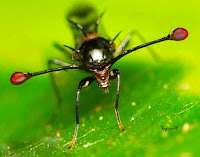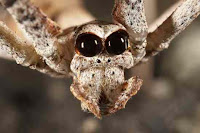10. Tarsier
 |
| Tarsier |
The tarsier has enormous eyes, the largest of any mammal, relative to body size. Each eye is weighing more than its brain. These enormous eyes can’t be turn in their sockets because they are fixed in the skull. To compensate for this, the tarsier has a very flexible neck, and can rotate its head 180 degrees, just like an owl, to scan for potential prey or predators.
The tarsier has extremely acute eyesight and superb night vision; it has even been suggested that they may be able to see ultraviolet light. On the other hand, they seem to have very poor color vision, as is the case with many nocturnal animals (including house cats and owls, for example). This small nocturnal primate can be found in the rainforests of South Eastern Asia.
The tarsier has extremely acute eyesight and superb night vision; it has even been suggested that they may be able to see ultraviolet light. On the other hand, they seem to have very poor color vision, as is the case with many nocturnal animals (including house cats and owls, for example). This small nocturnal primate can be found in the rainforests of South Eastern Asia.
9. Chameleon
 |
| chameleon |
When the chameleon sees a potential prey, it focuses both eyes in the same direction, gaining stereoscopic vision. It’s very important because the chameleon captures prey by shooting out its tongue at high speed, a technique that requires a very precise distance and depth perception. Chameleons have very sharp eyesight, being able to see an insect several meters away, and just like the tarsier, they can see ultraviolet light.
8. Dragonfly
 |
| dragonfly |
Dragonflies also have three smaller eyes named ocelli which can detect movement faster than the huge compound eyes can. These ocelli quickly send visual information to the dragonflies’ motor centers, allowing it to react in a fraction of a second and perhaps explaining the insect’s formidable acrobatic skills. Some wasps and flies have ocelli too, but Dragonflies do have the most developed ones.
7. Leaf tailed gecko
 |
| leaf tailed gecko |
Leaf tailed geckos also have a series of strange, intricate eye patterns, which provide camouflage. They lack eyelids; their eyes are protected by a transparent membrane. They are often seen cleaning this membrane with their tongue.
6. Colossal squid
 |
| colossal squid |
The Colossal squid has stereoscopic vision, having a greater ability to judge distances. Even more amazing, each eye has a built-in “headlight”, an organ known as a photophore which can produce light so that whenever the Colossal squid focuses its eyes to the front, the photophores produce enough light for the squid to see its prey in the dark.
5. Four eyed fish
 |
| four eyed fish |
Although both halves of the eye use the same lens, the thickness and curve of the lens is different in the upper and lower eye halves, thus correcting for the different behavior of light in air and water. This means that when the four eyed fish is completely submerged, the upper halves of the eyes are out of focus. Fortunately, the fish spends almost its entire life in the surface, and it only has to dive completely once in a while to prevent the upper halves of the eyes from dehydrating. Four eyed fish can be found in Mexico and Central America, as well as Northern South America.
4. Stalk eyed fly
 |
| stalk eyed fly |
Males during mating season often stand face to face and measure their eyestalk’s length; the one with the greatest “eye span” is recognized as the winner. They also have the extraordinary ability to enlarge their eyestalks by ingesting air through their mouth and pumping it through ducts in the head to the eyestalks.
3. Spookfish
 |
| spookfish |
This “mirror” is superior at gathering light than the normal eye; the diverticulum reflects light and focuses it onto the retina allowing the fish to see both up at down at the same time. This deep water, ghostly-looking fish is the only vertebrate known to use a mirror eye structure to see, as well as the usual lens. Spookfish live at a depth of 1000-2000 meters feeding on small crustaceans and plankton.
2. Ogre faced spider
 |
| ogre faced spider |
Ogre faced spiders can see perfectly at night even though they lack tapetum lucidum, a reflective membrane that helps others spiders (and other predators such as cats) to see in low light conditions. Scientists believe that ogre faced spiders can see up to 100 times better than humans at night.
1. Mantis shrimp
 |
| mantis shrimp |
Their eyes are compound, like those of the dragonfly, but they have a far smaller number of ommatidia (about 10.000 per eye). However, in the mantis shrimp each ommatidia row has a particular function. For example, some of them are used to detect light, others to detect color, etc.
Mantis shrimp have much better color vision than humans, as well as ultraviolet, infrared and polarized light vision, thus having the most complex eyesight of any animal known. Their eyes have 12 types of color receptors, whereas humans have only three. The eyes are located at the end of stalks, and can be moved independently from each other, rotating up to 70 degrees. Interestingly, the visual information isn't processed by the brain but the eyes themselves.
Even more bizarre; each of the mantis shrimp’s eyes is divided in three sections allowing the creature to see objects with three different parts of the same eye. In other words, each eye has “trinocular vision” and complete depth perception, meaning that if a mantis shrimp lost an eye, its remaining eye would still be able to judge depth and distance as well as a human with his two eyes. Scientists are only starting to understand the mysteries of Stomatopod vision; for the moment, we can only imagine what the world really looks like to a mantis shrimp.
Source: 10 Animals With Incredible Eyes

No comments:
Post a Comment